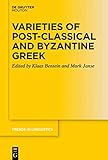Varieties of Post-classical and Byzantine Greek / ed. by Klaas Bentein, Mark Janse.
Material type: TextSeries: Trends in Linguistics. Studies and Monographs [TiLSM] ; 331Publisher: Berlin ; Boston : De Gruyter Mouton, [2020]Copyright date: ©2021Description: 1 online resource (XVIII, 429 p.)Content type:
TextSeries: Trends in Linguistics. Studies and Monographs [TiLSM] ; 331Publisher: Berlin ; Boston : De Gruyter Mouton, [2020]Copyright date: ©2021Description: 1 online resource (XVIII, 429 p.)Content type: - 9783110608557
- 9783110614633
- 9783110614404
- 480.9 23
- PA227 .V37 2021
- online - DeGruyter
- Issued also in print.
| Item type | Current library | Call number | URL | Status | Notes | Barcode | |
|---|---|---|---|---|---|---|---|
 eBook
eBook
|
Biblioteca "Angelicum" Pont. Univ. S.Tommaso d'Aquino Nuvola online | online - DeGruyter (Browse shelf(Opens below)) | Online access | Not for loan (Accesso limitato) | Accesso per gli utenti autorizzati / Access for authorized users | (dgr)9783110614404 |
Frontmatter -- Acknowledgments -- Contents -- List of contributors -- The Greek Alphabet -- List of abbreviations -- 1 Varieties of Post-classical and Byzantine Greek: Novel questions and approaches -- Part I: VARIETIES OF POST-CLASSICAL AND BYZANTINE GREEK -- 2 Tracking down lects in Roman Egypt -- 3 Idiolect in focus: Two brothers in the Memphis Sarapieion (II BCE) -- 4 Imposing psychological pressure in papyrus request letters: A case study of six Byzantine letters written in an ecclesiastical context (VI–VII CE) -- 5 Greek in Egypt or Egyptian Greek? Syntactic regionalisms (IV CE) -- 6 In search of an Egyptian Greek lexicon in Ptolemaic and Roman Egypt -- 7 Byzantine literature in “classicised” genres: Some grammatical realities (V–XIV CE) -- 8 From highly classicizing to common prose (XIII–XIV CE): The Metaphrasis of Niketas Choniates’ History -- 9 Back to the future: Akritic light on diachronic variation in Cappadocian (East Asia Minor Greek) -- Part II: DIMENSIONS OF VARIATION IN POST-CLASSICAL AND BYZANTINE GREEK -- 10 Tense variation in Ptolemaic papyri: Towards a grammar of epistolary dialogue -- 11 The Classical norm and varieties of Post-classical Greek: Expressions of anteriority and posteriority in a corpus of official documents (I–II CE) -- 12 Orthographic variation and register in the corpus of Greek documentary papyri (300 BCE–800 CE) -- 13 The Greek phonology of a tax collector in Egypt in the first century CE -- 14 Metrical variation in Byzantine colophons (XI–XV CE): The example of ἡ μὲν χεὶρ ἡ γράψασα -- 15 Arguing and narrating: Text type and linguistic variation in tenth-century Greek -- 16 The distinctiveness of syntax for varieties of Post-classical and Byzantine Greek: Linguistic upgrading from the third century BCE to the tenth century CE -- Index locorum -- Index nominum -- Index rerum
restricted access online access with authorization star
http://purl.org/coar/access_right/c_16ec
Linguistic varieties such as female speech, foreigner talk, and colloquial language have not gone unnoticed when it comes to Classical Greek, but little is known about later periods of the Greek language. In this collective volume leading experts in the field outline some of the most important varieties of Post-classical and Byzantine Greek, basing themselves on a broad range of literary and documentary sources, and advancing a number of innovative methodologies. Close attention is paid to the linguistic features that characterize these varieties, with in-depth discussions of lexical, morpho-syntactic, orthographic, and metrical variation, as well as the interrelationship between these different types of variation. The volume thus offers valuable insights into the nature of Post-classical and Byzantine Greek, laying the foundation for future studies of linguistic variation in these later stages of the language, while at the same time providing a point of comparison for Classical Greek scholarship
Issued also in print.
Mode of access: Internet via World Wide Web.
In English.
Description based on online resource; title from PDF title page (publisher's Web site, viewed 25. Jun 2024)


